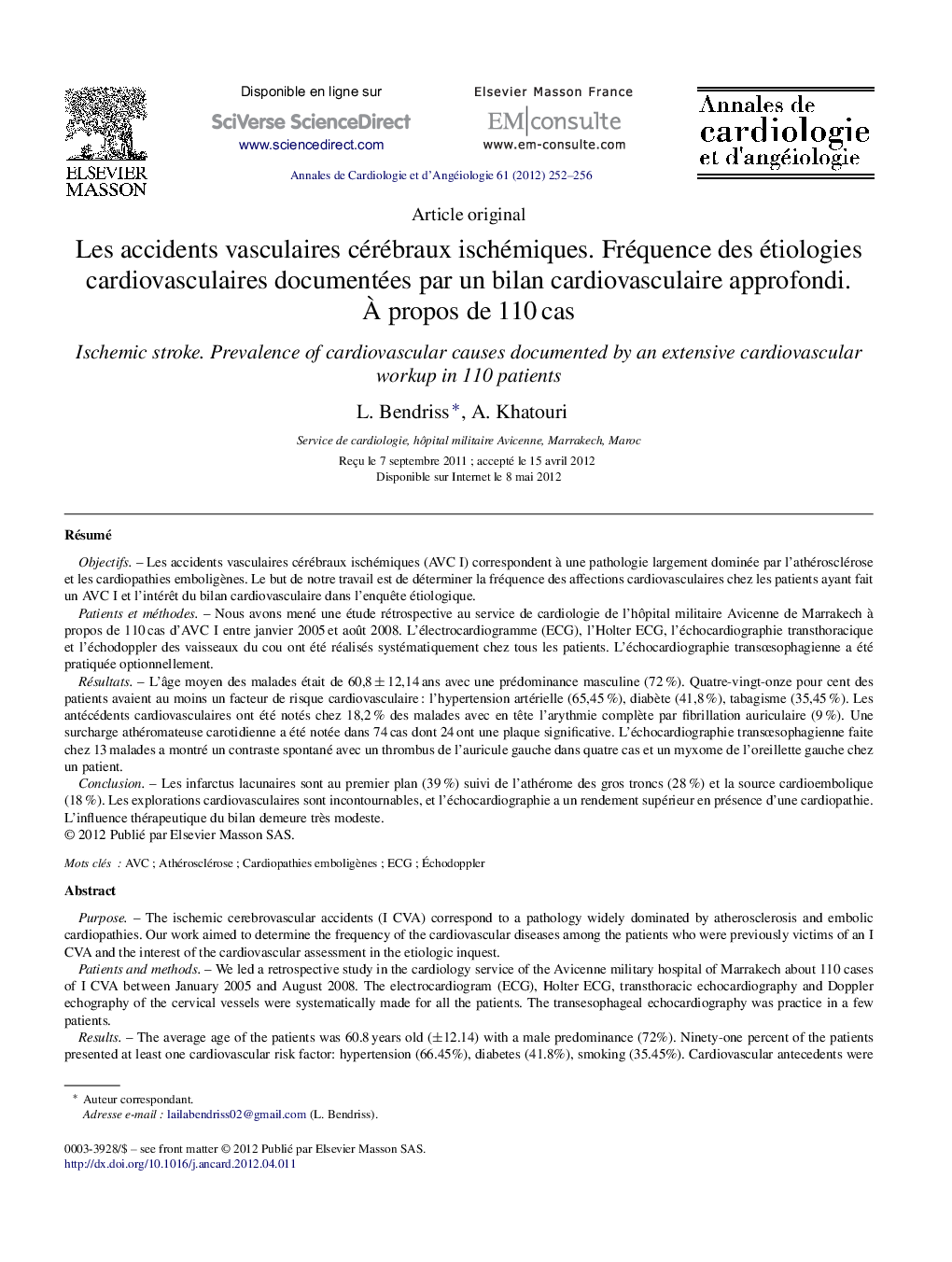| Article ID | Journal | Published Year | Pages | File Type |
|---|---|---|---|---|
| 2869069 | Annales de Cardiologie et d'Angéiologie | 2012 | 5 Pages |
RésuméObjectifsLes accidents vasculaires cérébraux ischémiques (AVC I) correspondent à une pathologie largement dominée par l’athérosclérose et les cardiopathies emboligènes. Le but de notre travail est de déterminer la fréquence des affections cardiovasculaires chez les patients ayant fait un AVC I et l’intérêt du bilan cardiovasculaire dans l’enquête étiologique.Patients et méthodesNous avons mené une étude rétrospective au service de cardiologie de l’hôpital militaire Avicenne de Marrakech à propos de 110 cas d’AVC I entre janvier 2005 et août 2008. L’électrocardiogramme (ECG), l’Holter ECG, l’échocardiographie transthoracique et l’échodoppler des vaisseaux du cou ont été réalisés systématiquement chez tous les patients. L’échocardiographie transœsophagienne a été pratiquée optionnellement.RésultatsL’âge moyen des malades était de 60,8 ± 12,14 ans avec une prédominance masculine (72 %). Quatre-vingt-onze pour cent des patients avaient au moins un facteur de risque cardiovasculaire : l’hypertension artérielle (65,45 %), diabète (41,8 %), tabagisme (35,45 %). Les antécédents cardiovasculaires ont été notés chez 18,2 % des malades avec en tête l’arythmie complète par fibrillation auriculaire (9 %). Une surcharge athéromateuse carotidienne a été notée dans 74 cas dont 24 ont une plaque significative. L’échocardiographie transœsophagienne faite chez 13 malades a montré un contraste spontané avec un thrombus de l’auricule gauche dans quatre cas et un myxome de l’oreillette gauche chez un patient.ConclusionLes infarctus lacunaires sont au premier plan (39 %) suivi de l’athérome des gros troncs (28 %) et la source cardioembolique (18 %). Les explorations cardiovasculaires sont incontournables, et l’échocardiographie a un rendement supérieur en présence d’une cardiopathie. L’influence thérapeutique du bilan demeure très modeste.
PurposeThe ischemic cerebrovascular accidents (I CVA) correspond to a pathology widely dominated by atherosclerosis and embolic cardiopathies. Our work aimed to determine the frequency of the cardiovascular diseases among the patients who were previously victims of an I CVA and the interest of the cardiovascular assessment in the etiologic inquest.Patients and methodsWe led a retrospective study in the cardiology service of the Avicenne military hospital of Marrakech about 110 cases of I CVA between January 2005 and August 2008. The electrocardiogram (ECG), Holter ECG, transthoracic echocardiography and Doppler echography of the cervical vessels were systematically made for all the patients. The transesophageal echocardiography was practice in a few patients.ResultsThe average age of the patients was 60.8 years old (±12.14) with a male predominance (72%). Ninety-one percent of the patients presented at least one cardiovascular risk factor: hypertension (66.45%), diabetes (41.8%), smoking (35.45%). Cardiovascular antecedents were noted among 18.2% of the patients, the continuous atrial fibrillation comes first (9%). A carotid atheromatous excess was noted in 74 cases of which 24 with a significant plaque. The transesophageal echocardiography made to 13 patients showed a spontaneous echo contrast with a left atrial thrombus in four cases and a left atrial myxoma in one patient.ConclusionPenetrating artery disease occupies 39%, large artery atherosclerosis 28% and cardiogenic stroke 18%. The cardiovascular assessment is indispensable, and the echocardiography is more interesting in presence of cardiopathy. Its therapeutic repercussion is modest.
